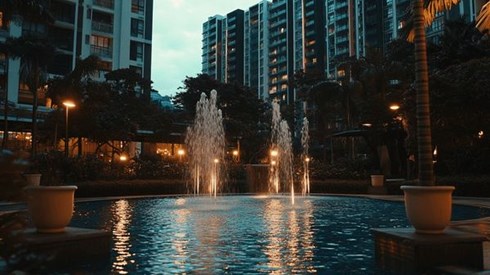Property Captives Flourish Despite Softening Market

Joanne Wojcik | May 23, 2025

The softening property insurance market has done little to suppress the upsurge of captives being used to fund this risk.
If anything, it has given commercial property owners a bit of a reprieve while they ponder how best to use captives to reduce the impact of insurance market cycles on their risk-financing strategies.
And in some cases, companies are considering the use of captives to address a previously unforeseen risk: tariffs.
Driven by increased insurer competition, property rates decreased by 6 percent globally in the first quarter of 2025, according to Marsh's Global Insurance Market Index. The United States and Pacific regions experienced the largest decreases, at 9 percent, while rates in the United Kingdom declined 6 percent, and all other regions experienced low single-digit declines. Clients also were able to negotiate improved terms and conditions on their property insurance programs, the report found.
Despite the recent market softening, the use of captives to finance all types of property/casualty risks continues to grow, according to captive industry experts. The total number of captives worldwide increased 1.8 percent to 6,290 at year-end 2024, according to Business Insurance magazine.
"Even though we saw a 6 percent reduction in premiums, the soft market is not slowing the growth of captives," noted Michael Serricchio, US and Canada regional leader at Marsh Captive Solutions. "Clients are continuing to build and grow their captives to not be at the mercy of the commercial insurance marketplace. We saw about a 9 percent increase from 2024 to 2025 in the amount of all-risk property premiums that were put through our captives." This follows a 29 percent increase from 2023 to 2024.
"And just because the property rate index is coming down, that doesn't mean a company in Florida, or LA or Louisiana, or in a quake-prone zone is going to have the market on their side," Mr. Serricchio continued.
Moreover, once a company forms a captive, it tends to expand it by adding other lines of coverage, treating it as yet another insurance market, he said. About 15 percent of the captives Marsh manages insure more than one risk, he estimates.
"They're used to taking risks, so they don't just take the property out because the market rate indexes come down 6 percent," Mr. Serricchio said.
Other industry experts echoed Mr. Serricchio's sentiments.
"Captives continue to be a good solution for property coverage, regardless of market conditions," said Dan Towle, president of the Captive Insurance Companies Association, a captive industry trade group based in Minneapolis.
In fact, in some cases, he is seeing captives take larger retentions. "Uncertainty in the market typically increases the interest in captive formations and in the expansion of lines of coverage."
"I personally believe we're in the Golden Age of captives if you look at the growth we've had across the industry in North America over the past [3 or 4] years," said Barry White, Annapolis-based executive vice president at Artex Risk Solutions North America, the captive management arm of broker Arthur J. Gallagher & Co.
He said he has witnessed significant growth in the formation of single-parent captives across myriad industries—retail, construction, higher education, manufacturing, transportation, multifamily housing, and agriculture. In addition, he has seen a number of captives adding property to their existing programs.
"We are still seeing a significant flow of inquiries," Mr. White said. "I think, basically, they're looking to a longer-term strategy. They don't want to be behind the eight ball when the market hardens again. So, we are seeing clients using captives to insulate themselves from market cycles."
In some ways, the softening market, coming off a very hard market, is giving companies a little breathing room before jumping into the captive arena, suggested T.J. Scherer, vice president at Spring Consulting Group in Boston.
"We were approached all of last year with, 'Hey, my renewal's up 20 percent. What can I do?' And they were approaching us 60 days before renewal. But there was nothing we could really do because we didn't have enough time to evaluate the losses, decide if it's fair pricing, [or] look at what risk they may want to take. Now that there's less pressure, it's giving them time to really think through the process," Mr. Scherer said.
Though captives have long been used to finance large deductibles in property insurance programs, today, they are also being used to fill in primary layers, provide excess coverage, participate in quota shares, access reinsurance markets, and cover terrorism risk.
In some, albeit rare, cases, captives are being used to access parametric solutions, particularly for wind, flood, and earthquake exposures. In addition to covering property damage in certain situations, such as when wind speeds exceed certain miles per hour, parametric payments can be used to reimburse expenses not typically covered by traditional property policies, like business interruption, extra expenses, employee assistance, etc.
"If they're sophisticated enough to be talking about parametrics, and the risk manager or the treasury folks are very comfortable with the captive, they will use it like a central processing vehicle to access the parametric solution," Mr. Serricchio explained.
Since President Trump took office, risk managers have become increasingly concerned about the impact that new tariffs assessed on imported building materials might have on their property loss costs.
"This is a new phenomenon, and risk managers are having to make adjustments to their programs," said Mr. Towle.
Indeed, some companies are contemplating ways to use their captive insurers to address their new tariff exposures.
"They're looking at their diminished revenue, they're looking at their tariff exposure, [and] they're looking at their trade partners and shipping costs and containers and supply chains and all of that. Lo and behold, captives are at the forefront of those things. They are going to serve the purpose that they were intended to," Mr. Serricchio said.
Mr. Scherer likened the situation to a few years ago when insurers imposed wind buy-downs that were often more expensive than the cost of a loss.
"People were looking at just having those taken into their captive or fronted," he recalled. "If rebuilding costs become significantly higher and the insurers add exclusions related to material price increases, all the more reason to have a captive write a difference-in-conditions policy if you're starting to see certain exclusions show up."
Joanne Wojcik | May 23, 2025
